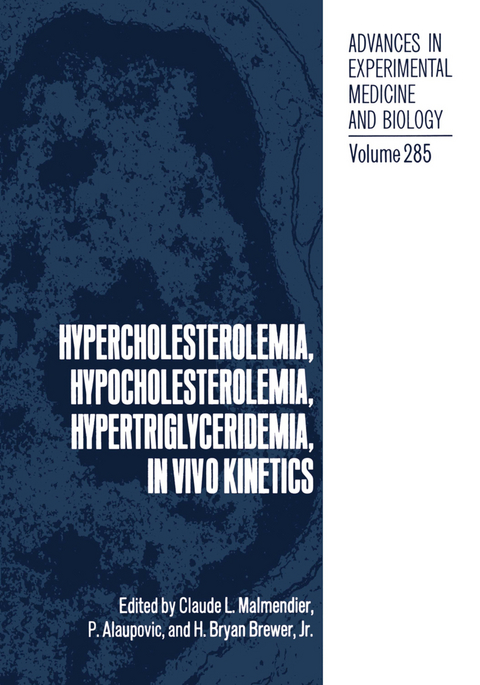
Hypercholesterolemia, Hypocholesterolemia, Hypertriglyceridemia, in Vivo Kinetics
Springer-Verlag New York Inc.
978-1-4684-5906-7 (ISBN)
The past two decades have seen steady progress in our understanding of the pathogenesis of atherosclerosis. The role of low density lipoprotein (LOL) increase and of LOL receptor deficiency or malfunctions in familial hypercholesterolemia has been largely enlightened by the works of Brown and Goldstein. These authors postulated also that modification of LOL to a form recognized by the scavenger or acetyl-LOL receptor may be required for lipid loading of macrophage-derived foam cells in the lesions. A growing body of evidence suggests that oxidative modification of LOL could enhance its atherogenicity by its implication as a factor in the generation of foam cells. Thus, if the role of LOL in the pathogenesis of hypercholesterolemia was well established a great deal of information appears currently on new approaches such as the mechanisms leading to the accumulation of foam cells, the impact of LOL structural alterations, notably oxidation and the role of gene mutations of apolipoprotein Band/or LOL receptor The opening topic is devoted to these new avenues outlined in the field of hypercholesterolemia. The first part concerns the genetic aspects of atherosclerosis: mainly the genetics of apo 1 ipoprote ins , their transcriptional regulation, the amino acid mutations of the apo B gene and of the LOL receptor gene, the structural domains and the acylation sites of apoprotein B.
Cholesterol Metabolism.- Transcriptional Regulation of the Human Apolipoprotein Genes.- Mutations and Variants of Apolipoprotein B that Affect Plasma Cholesterol Levels.- Molecular Genetics of Familial Hypercholesterolemia.- Investigation of Structural Domains on Human Serum Low Density Lipoprotein and Apolipoprotein B100.- Implications of Thiolester Linked Fatty Acids in Apolipoprotein B.- Factors Regulating the Distribution of Cholesterol between LDL and HDL.- Regulation of Hepatic Lipase Expression by an Intermediate of the Cellular Cholesterol Biosynthetic Pathway.- Human Plasma Lecithin:Cholesterol Acyltransferase (LCAT). On the Role of Essential Carboxyl Groups in Catalysis.- Plasma Lipoprotein Phenotype in Response to Cholesteryl Ester Transfer Protein Levels in Dyslipoproteinemia.- HDL Receptor-mediated Cholesterol Efflux from Cells and its Regulation.- Binding of Apolipoproteins A to Adipose Cells: Role of Receptor Sites in Cholesterol Efflux and Purification of Binding Protein(S).- Lipoprotein A-I Containing Particles..- Distribution of Cholesterol within High Density Lipoproteins Fractionated by Immunoaffinity Chromatography.- Metabolic Role of Human Apopoprotein A-IV.- Regression of Atheroma and Putative Role of CETP in Cholesteryl Ester Removal.- Symmetry of the Surface, and Structure of the Central Core of Human LDL Particles, Analyzed by X-ray Small Angle Scattering.- Role of Amphipathic Helixes in HDL Structure/Function.- Conformational Properties of Apolipoproteins Studied by Computer Graphics.- Alterations of High Density Lipoproteins Induced by ThyroidHormones in Man and Rat 147.- The HELP-system in the Treatment of Severe Hypercholesterolaemia: Acute and Long-term Experience.- Familial Hypocholesterolemia and HDL Deficiency.- Mechanisms of Hypocholesterolemia.- Origin of Cholesterol and Bile Acids in the Diverted Bile of Two Patients with Total Small Bowel Resection.- In Vivo Kinetics.- Berman’s Simulation Analysis and Modeling.- Considerations in Designing and Analyzing Data from Apo-B Turnover Studies.- What Is Meant by Overproduction of Apo B-containing Lipoproteins?.- Kinetics of Heterogeneous Populations of Particles.- HDL Metabolism in HDL Deficiency Associated with Familial Hypertriglyceridemia: Effect of Treatment with Gemfibrozil.- Recent Advances in Lipoprotein Metabolism and the Genetic Dyslipoproteinemias.- Kinetic Studies of the Origin of Apolipoprotein (apo) B-100 in Low Density Lipoproteins of Normal and Watanabe Heritable Hyperlipemic (WHHL) Rabbits.- Alterations in Cholesterol Metabolism in the Genetically Hypercholesterolemic RICO Rat: An Overview.- Hypertriglyceridemia.- Genetic Variation at the Lipoprotein Lipase Gene Associates With Coronary Arteriosclerosis.- The Lipid Surface of Triglyceride-Rich Particles Can Modulate (Apo)Protein Binding and Tissue Uptake.- Structure and Metabolism of Low Density Lipoproteins from Normaland Hypertriglyceridemic Subjects 289.- The ApoB 100-apo(a) Complex: Relation to Triglyceride-Rich Particles.- ApoB-Containing Lipoprotein Particles as Risk Factors for Coronary Artery Disease.- In Vitro Binding and In Vivo Uptake of Chylomicron Remnants after their Hydrolysis by Hepatic Lipase.- The Endocytosis of Lipoproteins by the Liver and their Intracellular Pathway in Comparision to other Ligands.- Concomitant Inhibition of VLDL Triglyceride and Apoprotein Secretion by Hepatocytes of Rats Adapted to a High-fat Diet.- Molecular Genetics of ApoC-II and Lipoprotein Lipase Deficiency.- What Factors Regulate the Action of Lipoprotein Lipase?.- Pathogenesis ofAtherosclerosis.- Cytotoxicity of Remnants of Triglyceride-Rich Lipoproteins: An Atherogenic Insult?.- The Role of Oxidized LDL in Atherosclerosis.- Probucol and its Mechanisms for Reducing Atherosclerosis.- Proteoglycans, Lipoproteins, and Atherosclerosis.- Immune Mechanisms in the Pathogenesis of Atherosclerosis.- Cholesterol Level in Circulating Immune Complexes as a Marker of Coronary Atherosclerosis.- Antibody-like Immunoglobins G against Low Density Lipoprotein that Stimulate Lipid Accumulation in Cultured Cells.- Nutritional Regulation of Apolipoprotein Genes: Effect of Dietary Carbohydrates and Fatty Acids.- Lipoprotein Structure and Metabolism During Progression and Regression of Atherosclerosis in Pigs Fed With Pish Oil-Derived Fatty Acids.- Contributors.
| Reihe/Serie | Advances in Experimental Medicine and Biology ; 285 |
|---|---|
| Zusatzinfo | 454 p. |
| Verlagsort | New York, NY |
| Sprache | englisch |
| Maße | 178 x 254 mm |
| Themenwelt | Sachbuch/Ratgeber ► Natur / Technik ► Garten |
| Medizinische Fachgebiete ► Innere Medizin ► Diabetologie | |
| Medizinische Fachgebiete ► Innere Medizin ► Endokrinologie | |
| Studium ► 1. Studienabschnitt (Vorklinik) ► Biochemie / Molekularbiologie | |
| Studium ► 2. Studienabschnitt (Klinik) ► Humangenetik | |
| Naturwissenschaften ► Biologie ► Biochemie | |
| ISBN-10 | 1-4684-5906-6 / 1468459066 |
| ISBN-13 | 978-1-4684-5906-7 / 9781468459067 |
| Zustand | Neuware |
| Haben Sie eine Frage zum Produkt? |
aus dem Bereich


